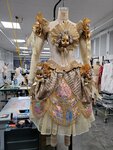Wind: mph,
Welcome to our new web site!
To give our readers a chance to experience all that our new website has to offer, we have made all content freely avaiable, through October 1, 2018.
During this time, print and digital subscribers will not need to log in to view our stories or e-editions.




“The Nutcracker” has always been part of Joshua L. Peugh’s life, from childhood attendance to mainstay of his dancing career. There were some years he danced in the iconic production some 65 times with the dance company he was working for.
“I think it’s such an iconic piece of work and my question is, why does it persist?” Peugh, the artistic director of Dark Circles Contemporary Dance Company, said.
The ballet was introduced in Russia in July 1982 and failed terribly, he said. The composer, Pyotr Tchaikovsky, did not like it and so it disappeared. Resurfacing in 1944 when the San Francisco Ballet decide to produce “Nutcracker,” and it spread like wildfire.
“It became a million different things to a million different people,” Peugh said. “Dancers start dancing because they saw the ‘Nutcracker.’ It was a way to see a path forward (for dancers). A lot of dance can be prohibitive, art that doesn’t really belong to everyone. So, part of our project and mission has always been to get LGBTQIA+ people on stage where people can feel like the space belongs to them.”
So Dark Circles is reimagining the classic as it produces a short dance film, "Queering the Second Act." The project features choreography by Peugh and takes the classic ballet in a unique imagining by celebrating the eccentricity and queerness of the original fairytale by E.T.A. Hoffman.
Peugh said looking at the source material for the ballet, there is not much recognizable in what is done with the text of the story. Hoffman was a civil servant who wanted to be an artist and believed that children were losing their imagination. He wrote the story to point out children were losing their imagination.
“So the whole second half is about imagination and about Drosselmeyer pushing Marie into favoring her imagination into the domestic sphere,” Peugh said. “So, our goal is to have the second half to be all imagination. We are getting outside of the domestic heteronormative and turning up the imagination and the fantasy.”
“Queering the Second Act” features two male-identified dancers replacing the Sugar Plum Fairy and her Cavalier.
“This work challenges barriers within the dance community, particularly in embracing male/male partnering and LGBTQ+ narratives,” he said. “It reinforces our dedication to assertively amplifying diverse voices and stories.”
The production scales down the focus on traditional technical hugeness, setting the piece in a smaller space with smaller cast. Rather than an orchestra, there will be a single musician, pianist Marco Jimenez, playing the iconic music. The costumes, too, are scaled down.
Working with a professional costume designer for three years, Peugh asked her to come up with some interesting designs to match his vision for the production.
“She has expanded my vision and it’s always fun to work with collaborators,” he said. “And I think there is something interesting to shrink the sound. With a small cast, chamber-sized makes sense to me and is exciting to me.
“I wanted to do work that felt a bit less about technical prowess and more about leaving the audience with questions about human nature and why we do what we do.”
Dancers include Chadi El-Khoury, Gavin Stewart and Vanessa Owen, who bring their unique artistry and energy to the project, Peugh said.
"Queering the Second Act" will be streaming on demand, pay-what-you-can, Dec. 21- Jan 3. Visit DarkCirclesContemporaryDance.com to sign up for access.